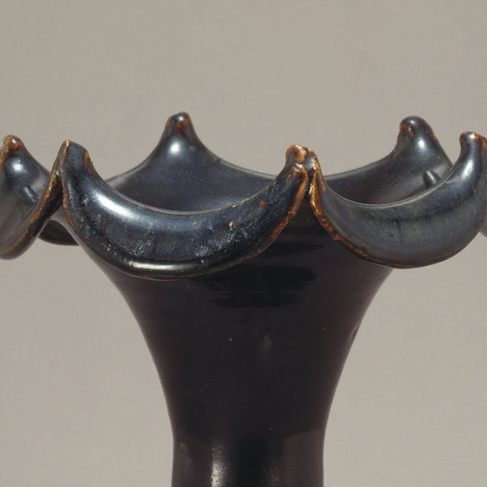宋代筆記 vol.145 東京富士美術館:黒釉堆線文瓶 - FAM, Vase with Vertical Ribs, Black Glaze, Song Dynasty
- SACA

- Aug 17
- 8 min read

黑釉堆線文瓶
金代(12–13世紀)高33.6公分、口徑15.1公分、胴徑14.7公分、底徑12.2公分
東京富士美術館藏
此瓶作外撇高圈足,胴腹鼓起,長頸挺拔,上承呈喇叭形外張之口沿。口緣以切割手法分作六瓣,形似綻放的百合花瓣,故名「百合口」。胴部飾以白土條帶,沿胎土表面縱向反覆貼附,復以黑釉通體罩燒,釉層下白線條清晰浮現,形成鮮明的縱向裝飾紋。此種技法稱作「堆白線文」,為金代磁州窯系常見的裝飾手法。百合口之造型則始見於宋代器物,為當時流行之典型樣式。
磁州窯系磁州窯系自五代末期至近代皆有燒造,其窯址主要分布於河北省邯鄲一帶。其典型技法為灰色胎土上施以白化妝土,再施透明釉高溫燒成。其裝飾風格多樣,包含素白釉、白地剔花、白地黑剔花、白地鐵繪、白地紅綠彩、黑釉、翡翠釉等,器類亦十分豐富。類似的生產亦廣泛見於河北、北京、河南、安徽、山西、山東及陝西等地,統稱為「磁州窯系」。北宋時期已出現白地剔花,至北宋晚期白地黑剔花盛行。金代以後,白地鐵繪成為主流裝飾手法,同時亦出現以複數彩料進行上彩裝飾之器物,即日本所稱「宋赤繪」,可謂中國多彩釉上彩繪的濫觴。

宋代黑釉瓶與磁州窯藝鑒賞:常見問題
1. 這件「黑釉堆線文瓶」是哪個朝代的器物?它的主要特徵是什麼?
這件「黑釉堆線文瓶」是金代(12–13世紀)的器物。其主要特徵包括:外撇高圈足、鼓起的胴腹、挺拔的長頸以及喇叭形、切割成六瓣的「百合口」。器身飾有「堆白線文」技法,即在胎土上縱向貼附白土條帶,再施以黑釉,使白色線條在黑釉下清晰浮現,形成鮮明的縱向紋飾。
2. 「百合口」這種造型最早出現在什麼時候?它有何特殊意義?
「百合口」這種造型始見於宋代器物,是當時流行的典型樣式。它將口沿切割成六瓣,形似綻放的百合花瓣,因此得名。這種設計不僅增加了器物的美感,也體現了宋代器物造型的雅緻與自然元素的融合。
3. 「堆白線文」是一種什麼樣的裝飾技法?它在何時何地流行?
「堆白線文」是一種獨特的裝飾技法,透過在胎土表面縱向連續貼附白土條帶,再整體罩燒黑釉,使白線條在釉層下清晰顯現,形成引人注目的垂直紋理。這種技法在金代(12–13世紀)的磁州窯系中廣泛應用,是該時期磁州窯系常見的裝飾手法之一。
4. 磁州窯系窯址主要分佈在哪裡?其燒造歷史有多長?
磁州窯系窯址主要分佈於河北省邯鄲一帶。其燒造歷史悠久,自五代末期一直延續至近代,顯示了其陶瓷生產的持久影響力。
5. 磁州窯系的基本燒製技法是什麼?其裝飾風格有哪些多樣性?
磁州窯系的基本燒製技法是在灰色胎土上施以白化妝土,再施透明釉並進行高溫燒成。其裝飾風格極為多樣,包括素白釉、白地剔花、白地黑剔花、白地鐵繪、白地紅綠彩、黑釉、翡翠釉等。這種豐富的裝飾手法也體現在其多樣的器物種類上。
6. 磁州窯系的分佈範圍有多廣?為何統稱為「磁州窯系」?
磁州窯系的分佈範圍非常廣泛,類似的生產窯址不僅在河北省邯鄲,還廣泛見於河北、北京、河南、安徽、山西、山東及陝西等地。儘管窯址眾多且分佈廣泛,由於它們在胎土、化妝土、釉料、燒成技術和裝飾風格上具有相似性,因此被統稱為「磁州窯系」,形成一個龐大的陶瓷生產體系。
7. 磁州窯系的裝飾手法在不同時期有何演變?
磁州窯系的裝飾手法隨時間推移有所演變:
北宋時期:已出現白地剔花。
北宋晚期:白地黑剔花盛行。
金代以後:白地鐵繪成為主流裝飾手法。同時,也出現了以複數彩料進行上彩裝飾的器物,即日本所稱的「宋赤繪」,這標誌著中國多色彩釉上彩繪的濫觴。
8. 日本所稱的「宋赤繪」指什麼?它在中國陶瓷史上有何重要意義?
日本所稱的「宋赤繪」是指金代以後磁州窯系中出現的白地紅綠彩器物。這些器物以多種色彩進行上繪裝飾,被認為是中國多色彩釉上彩繪的濫觴。其重要意義在於,它代表了中國陶瓷裝飾從單色釉或釉下彩向多色彩、釉上彩繪的發展,為後世豐富多彩的陶瓷藝術奠定了基礎。

Vase with Vertical Ribs, Black Glaze
Jin dynasty (12th–13th century)
Height 33.6 cm; Mouth diameter 15.1 cm; Body diameter 14.7 cm; Base diameter 12.2 cm
Collection of the Fuji Art Museum, Tokyo
The vessel is supported on a flaring high ring foot, with a globular body, a tall upright neck, and a trumpet-shaped mouth rim. The mouth is cut into six segments, forming petal-like divisions reminiscent of a blooming lily, hence termed a “lily mouth” (百合口). The body is decorated with strips of white slip applied in vertical succession onto the clay surface; over this, a lustrous black glaze has been applied, allowing the white lines to stand out vividly beneath the glaze, producing striking vertical rib-like patterns. This decorative method, known as “applied white slip lines” (tui bai xian wen), was widely employed in the Jin period among the Cizhou-type wares. The lily-shaped mouth, on the other hand, is a form that first appeared in the Song dynasty and became a favored stylistic feature thereafter.
Cizhou Ware System
The Cizhou ware tradition extended from the late Five Dynasties period into modern times, with kiln sites primarily located in Handan, Hebei province. The standard technique involved applying a layer of white slip over a grey body, followed by a transparent glaze firing. Decorative styles were remarkably diverse, including plain white wares, white-ground carved designs, white-ground black-carved patterns, white-ground iron-painted motifs, white-ground polychrome in red and green, black glaze, and jade-green glaze, among others. The range of vessel types was equally varied. Kiln sites producing similar wares were widely distributed across Hebei, Beijing, Henan, Anhui, Shanxi, Shandong, and Shaanxi, collectively classified as the Cizhou ware system. White-ground carved designs already appeared in the Northern Song, with black-carved designs flourishing by the late Northern Song. From the Jin dynasty onwards, iron-painted white wares became mainstream, alongside the emergence of overglaze polychrome wares—known in Japan as “Song Aka-e” (宋赤絵)—representing the earliest stage of multicolored overglaze painting in Chinese ceramics.
What is the "Vase with Vertical Ribs, Black Glaze" and what are its key features?
The "Vase with Vertical Ribs, Black Glaze" is a ceramic vessel from the Jin dynasty (12th–13th century) held in the collection of the Fuji Art Museum, Tokyo. It stands 33.6 cm tall and features a flaring high ring foot, a globular body, a tall upright neck, and a distinctive trumpet-shaped mouth. This mouth is cut into six petal-like segments, resembling a blooming lily, hence it is known as a “lily mouth” (百合口). Its most striking decorative feature is the "applied white slip lines" (tui bai xian wen) on its body, where strips of white slip were applied vertically onto the clay surface and then covered with a lustrous black glaze, causing the white lines to vividly stand out beneath the dark glaze, creating a ribbed pattern.
How does the "lily mouth" feature relate to Chinese ceramic history?
The "lily mouth" (百合口) is a significant stylistic element of the "Vase with Vertical Ribs, Black Glaze." While the vase itself dates to the Jin dynasty, the lily-shaped mouth is noted as a form that first appeared during the earlier Song dynasty and subsequently became a favored stylistic feature in later periods. This indicates a continuity of certain design elements across different dynasties within Chinese ceramic production.
What is the "applied white slip lines" (tui bai xian wen) technique, and when was it prevalent?
"Applied white slip lines" (tui bai xian wen) is a specific decorative method used on the "Vase with Vertical Ribs, Black Glaze." It involves applying strips of white slip (a thin, liquid clay mixture) in vertical succession onto the grey clay body of the vessel. After this, a black glaze is applied over the entire piece. The white lines beneath the black glaze then stand out distinctly, creating a striking vertical ribbed pattern. This technique was widely employed, particularly during the Jin period, among wares belonging to the Cizhou-type ceramic tradition.
What is the Cizhou ware system, and where were its main production sites located?
The Cizhou ware system refers to a broad tradition of ceramic production that spanned from the late Five Dynasties period into modern times. Its primary kiln sites are concentrated in Handan, Hebei province. However, the influence and production of similar wares extended widely across various regions, including Hebei, Beijing, Henan, Anhui, Shanxi, Shandong, and Shaanxi, leading to the collective classification as the "Cizhou ware system."
What was the basic production technique for Cizhou ware?
The fundamental technique for Cizhou ware involved applying a layer of white slip (also referred to as "white cosmetic clay" or "白化妝土") over a grey clay body. After this white slip application, a transparent glaze was applied, and the piece was then fired at high temperatures. This foundational method allowed for a wide range of decorative variations.
What were some of the diverse decorative styles employed within the Cizhou ware system?
The Cizhou ware system was renowned for its remarkable diversity in decorative styles. These included plain white wares, white-ground carved designs (Bai-di Kaoluo), white-ground black-carved patterns (Bai-di Hei Kaoluo), white-ground iron-painted motifs (Bai-di Tiehua), white-ground polychrome in red and green, black glazes, and jade-green glazes. This extensive array of styles demonstrates the artistic versatility and innovation of the Cizhou kilns.
How did decorative styles evolve within the Cizhou ware system from the Northern Song to the Jin dynasty?
The evolution of decorative styles within the Cizhou ware system shows distinct trends. White-ground carved designs (Bai-di Kaoluo) first appeared in the Northern Song dynasty, with white-ground black-carved designs (Bai-di Hei Kaoluo) becoming particularly popular by the late Northern Song. As the Jin dynasty began, iron-painted white wares (Bai-di Tiehua), characterized by brush-painted motifs, became the mainstream decorative approach. This period also saw the emergence of overglaze polychrome wares, known in Japan as "Song Aka-e" (宋赤絵), which represented the earliest form of multi-colored overglaze painting in Chinese ceramics.
What is "Song Aka-e" (宋赤絵) and its significance?
"Song Aka-e" (宋赤絵) refers to a type of white-ground polychrome ware, specifically those decorated in red and green, that emerged during the Jin dynasty. It is significant because it represents the earliest stage or the "dawn" of multicolored overglaze painting in Chinese ceramics. This marked a crucial development in ceramic decoration, moving beyond underglaze or single-color glaze techniques to incorporate multiple colors applied over the glaze.

黒釉堆線文瓶
Vase with Vertical Ribs, Black Glaze
金(12-13世紀)/
高33.6cm、口径15.1cm、胴径14.7cm、底径12.2cm
裾が広がった高台を持ち、胴部は膨らみを持つ。長い頸部からラッパ状に開いた口縁に、切り込みを入れて6つの花弁状になった百合口を持つ瓶である。胴部には、素地に白土の線を連続して貼り付け、その上から黒釉を全体に掛けて、白い筋が浮き上がった文様を生み出している。このような文様は「堆白線文」(ついはくせんもん)と呼ばれ、金時代に多用された。百合の花に例えられた百合口は、宋時代以降にみられる形である。
磁州窯系
A Type of Ci-zhou Ware
五代時代末期から近代の窯。窯跡は、河北省邯鄲市に分布。灰色の胎土に白化粧を施し、透明釉をかけて焼成するのが基本的な技法。文様装飾は白無地、白地掻落、白地黒掻落、白地鉄絵、白地紅緑彩、黒釉、翡翠釉など多彩で、器種も豊富。同種の製品を焼造する窯跡は、河北省、北京市、河南省、安徽省、山西省、山東省、陝西省に広く分布し、磁州窯系と総称。北宋時代には白地掻落が出現し、北宋時代末期には白地黒掻落が盛行。金時代以降は、筆彩で文様を表す白地鉄絵などが主流となる。また、同じ頃に作られた、わが国で「宋赤絵」と呼ばれる白地紅緑彩は、複数色の上絵付による文様表現の嚆矢。




























Comments